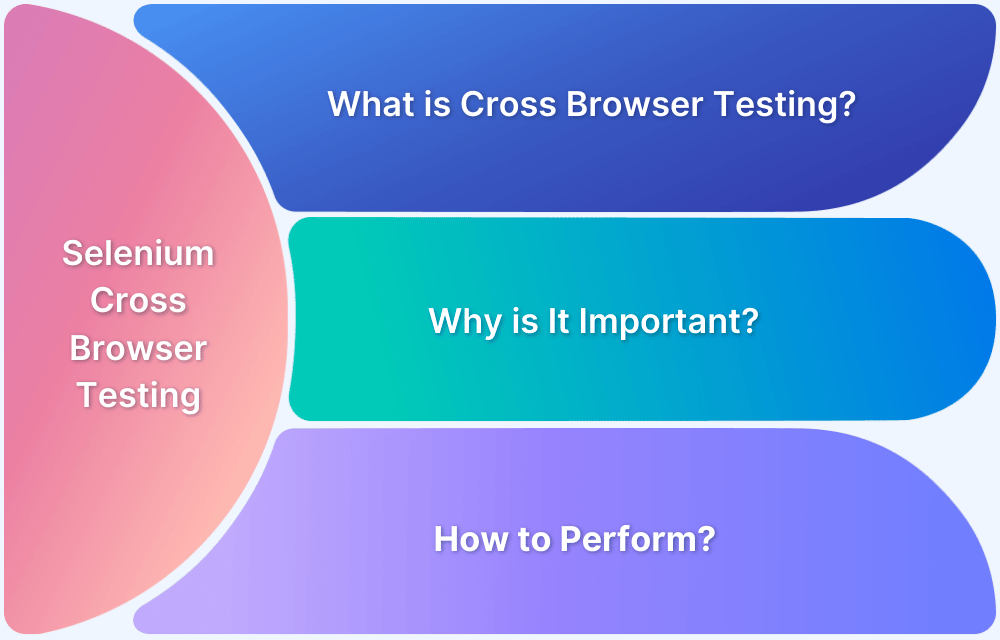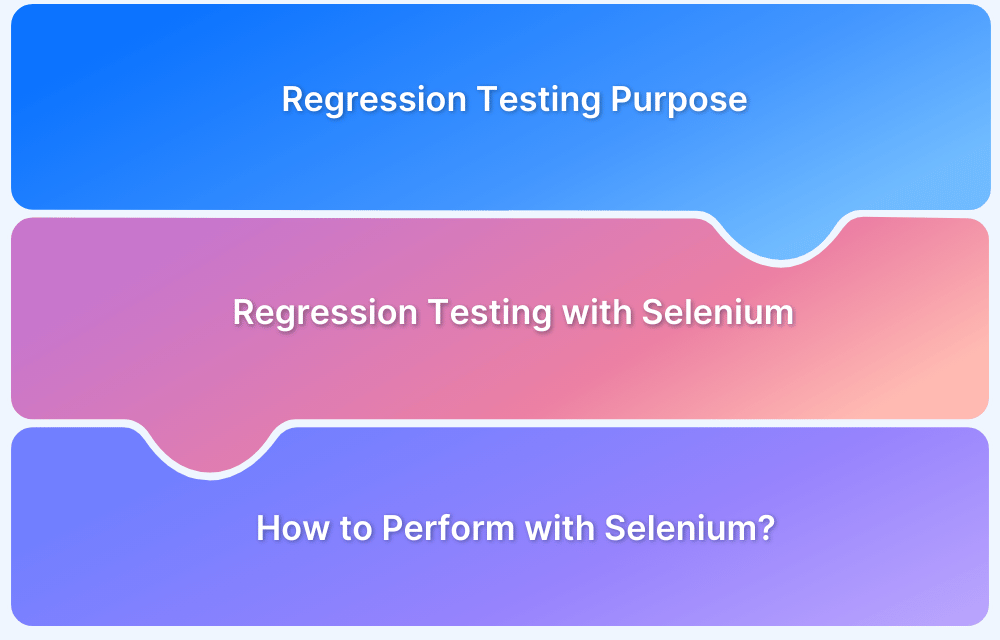Selenium is an acclaimed open-source framework for automating web browsers. It allows developers and testers to simulate real user actions on web applications, ensuring they work correctly across various browsers and devices. Thanks to its flexibility, support for multiple programming languages, and compatibility with different operating systems, Selenium is a top choice for automation testing.
This article explores ten creative and practical project ideas using Selenium. These projects cater to all skill levels and are a great way to improve both your testing expertise and proficiency with the tool.
Why Choose Selenium?
Selenium is a favorite among developers and testers for a variety of reasons. Here’s why:
- Cross Browser Testing: Selenium works with all major browsers like Chrome, Firefox, Edge, and Safari. This makes it perfect for ensuring consistent behavior across different platforms. Additionally, integrating Selenium with BrowserStack allows for cloud-based testing on real devices and browsers, so you don’t have to manage your own infrastructure.
- Language Flexibility: Selenium supports multiple programming languages, including Java, Python, C#, and JavaScript. This gives developers the freedom to use the language they’re most comfortable with.
- Easy Integrations: Selenium integrates well with a range of tools, including Jenkins for CI/CD, TestNG for test reporting, and BrowserStack for scalable cross-browser testing and debugging.
- Scalability: Selenium Grid lets you run tests in parallel, saving valuable time and resources. When combined with BrowserStack, you can scale your testing to include multiple devices and browsers in the cloud.
By using Selenium alongside tools like BrowserStack Automate, teams can speed up testing while ensuring reliability across diverse environments, ultimately helping them deliver high-quality software faster.
This article outlines the top 10 Selenium project ideas designed to expand knowledge and expertise.
Top 10 Selenium Project Ideas
Here are top 10 Selenium Project Ideas:
- Automated Web Testing Framework for E-commerce Website
- Cross-Browser Testing
- Web Scraping with Selenium
- Automated Regression Testing for Web Applications
- Automated Data-Driven Testing for Login Systems
- Web Application Performance Testing Using Selenium
- Mobile Web Testing with Selenium
- Test Automation for REST APIs with Selenium
- Visual Testing with Selenium and Percy
- Form Validation Testing
Explore these innovative and practical project ideas in-depth to take your automation skills to the next level.
1. Automated Web Testing Framework for E-commerce Website
This project focuses on building a robust automation framework to test essential e-commerce functionalities such as product search, cart management, and checkout.
Brief Overview with Core Features:
- Automates UI interactions like adding products to the cart, navigating categories, and checking out.
- Verifies critical functionality, such as payment gateway integration and order confirmation.
- Ensures cross-browser compatibility with tools like BrowserStack, enabling testing across multiple devices and browsers.
Tools & Skills:
- Selenium WebDriver with Java or Python.
- TestNG for test management, Maven for project management.
- Knowledge of XPath, CSS selectors, and parallel test execution.
Features:
- Automates checkout processes to ensure smooth transactions.
- Verifies product search functionality and filter options.
- Tests cart features, including adding/removing items and calculating shipping costs.
Example Use Case:
Testing the user journey on popular e-commerce platforms like Amazon.
Challenges & Tips:
| Challenges | How to Overcome |
|---|---|
| Handling dynamic product pages | Use waits to manage asynchronous content and dynamic loading. |
| Testing on multiple browsers | Leverage BrowserStack to perform cloud-based cross-browser testing. |
2. Cross-Browser Testing
Cross Browser Testing project involves ensuring that a web application functions seamlessly across different browsers.
Brief Overview with Core Features:
- Ensures that web pages load and function correctly on browsers like Chrome, Firefox, Safari, and Edge.
- Integrates with BrowserStack to conduct real-time cross-browser testing on real devices.
- Uses Selenium Grid for parallel test execution, optimizing time and resources.
Tools & Skills:
- Selenium WebDriver with Java or Python.
- BrowserStack for real device cloud testing.
- Selenium Grid for running tests across multiple environments simultaneously.
Features:
- Validates UI consistency, including layout, fonts, and images.
- Ensures that all JavaScript and dynamic content is working as expected.
- Verifies browser-specific bugs and behaviors using tools like BrowserStack.
Example Use Case:
Testing corporate websites or e-commerce platforms to ensure cross-browser compatibility.
Challenges & Tips:
| Challenges | How to Overcome |
|---|---|
| Different rendering engines | Test with BrowserStack to see how browsers render content. |
| Handling browser-specific bugs | Use browser developer tools to pinpoint issues, and fix them accordingly. |
3. Web Scraping with Selenium
This project automates the extraction of data from websites, such as product details, user reviews, or pricing information.
Brief Overview with Core Features:
- Automates data collection from websites to gather valuable insights, like product prices, user ratings, or blog posts.
- Integrates with libraries like BeautifulSoup or Pandas to process and store the scraped data.
- Adheres to the ethical guidelines of web scraping to avoid overloading the target servers.
Tools & Skills:
- Selenium WebDriver with Python or Java.
- BeautifulSoup or Pandas for data processing.
- Knowledge of HTTP requests and handling CAPTCHAs when scraping.
Read More: Web Scraping using Beautiful Soup
Features:
- Scrapes dynamic content generated by JavaScript.
- Collects product information, including pricing, descriptions, and reviews.
- Processes and stores scraped data in a CSV or database for further analysis.
Example Use Case:
Scraping data from e-commerce platforms like eBay or Amazon to analyze product prices and reviews.
Challenges & Tips:
| Challenges | How to Overcome |
|---|---|
| CAPTCHAs during scraping | Use Selenium’s wait functions to handle CAPTCHAs or opt for API access where possible. |
| Handling large data sets | Use Python libraries like Pandas to manage and process large volumes of data efficiently. |
4. Automated Regression Testing for Web Applications
This project focuses on automating regression testing to ensure that new changes or features do not break existing functionality.
Brief Overview with Core Features:
- Automates the execution of test cases to verify that the core functionality remains intact after updates.
- Identifies and flags broken features or regressions after code changes.
- Ensures compatibility across different browsers and devices with BrowserStack.
Tools & Skills:
- Selenium WebDriver with Java or Python.
- TestNG or Pytest for test management.
- CI/CD integration tools like Jenkins for running automated regression tests.
Features:
- Validates core functionalities like login, user registration, and payment flows.
- Ensures no breakage of previously working features.
- Integrates automated tests into CI/CD pipelines to run regression tests on every build.
Example Use Case:
Testing a content management system (CMS) after updates to ensure the admin and user interfaces are not affected.
Challenges & Tips:
| Challenges | How to Overcome |
|---|---|
| Identifying regression errors | Set up comprehensive test cases that cover core functionalities. |
| Testing on multiple browsers | Use BrowserStack for testing on different browsers and devices in parallel. |
5. Automated Data-Driven Testing for Login Systems
This project focuses on automating login functionality tests with different data sets, validating different user credentials.
Brief Overview with Core Features:
- Uses external data sources (CSV, Excel) to input multiple sets of credentials.
- Automates login and checks for valid and invalid credentials, ensuring proper error messages are displayed.
- Ensures session timeouts and login persistence work correctly.
Tools & Skills:
- Selenium WebDriver with Python or Java.
- TestNG or Pytest for data-driven testing with external data sources.
- Knowledge of session handling and cookies.
Features:
- Validates login functionality with valid and invalid credentials.
- Ensures proper error handling and user feedback for incorrect inputs.
- Tests session timeout and login persistence functionality.
Example Use Case:
Testing the login functionality of social media applications or enterprise portals to ensure secure authentication.
Challenges & Tips:
| Challenges | How to Overcome |
|---|---|
| Managing large data sets | Use data-driven testing techniques with external data sources to handle multiple inputs. |
| Handling session timeouts | Implement explicit waits to manage session timeouts and cookie handling. |
6. Web Application Performance Testing Using Selenium
This project automates performance testing to analyze the speed and efficiency of web applications under varying loads.
Brief Overview with Core Features:
- Automates the testing of web page load times and server responses under different conditions.
- Measures page performance, including elements like JavaScript execution, DOM load times, and server response.
- Integrates with performance testing tools to monitor real-time performance.
Tools & Skills:
- Selenium WebDriver with Java or Python.
- Performance testing tools like JMeter or Apache Bench.
- Integration with BrowserStack to simulate tests across different browser/device combinations.
Features:
- Measures page load times under normal and high traffic conditions.
- Analyzes server response times and optimizes web performance.
- Performs stress testing with varying numbers of concurrent users.
Example Use Case:
Testing the performance of e-commerce platforms during major sales events like Black Friday.
Challenges & Tips:
| Challenges | How to Overcome |
|---|---|
| Simulating high traffic | Use tools like JMeter alongside Selenium for stress testing. |
| Measuring performance across devices | Use BrowserStack for cloud-based testing across real browsers and devices. |
7. Mobile Web Testing with Selenium
This project automates web testing on mobile browsers, ensuring that web applications are responsive and functional on mobile devices.
Brief Overview with Core Features:
- Automates testing of web applications on mobile browsers like Chrome on Android and Safari on iOS.
- Validates mobile-specific features like touch gestures, responsiveness, and mobile navigation.
- Leverages BrowserStack Automate for cloud-based mobile testing on real devices.
Tools & Skills:
- Selenium WebDriver with Java or Python.
- BrowserStack Automate for mobile web testing on real devices.
- Mobile-specific testing strategies like viewport resizing and touch actions.
Features:
- Ensures responsive design works across mobile devices.
- Validates mobile gestures such as swipe, pinch, and scroll.
- Tests mobile navigation, including menu functionality and links.
Example Use Case:
Testing mobile compatibility for websites like Twitter or Instagram, ensuring responsive behavior across Android and iOS devices.
Challenges & Tips:
| Challenges | How to Overcome |
|---|---|
| Testing on multiple devices | Use BrowserStack Automate to run tests on a variety of real mobile devices. |
| Handling touch gestures | Implement mobile-specific action methods in Selenium, like swipe and pinch. |
8. Test Automation for REST APIs with Selenium
This project focuses on automating the testing of RESTful APIs to ensure they return the correct data and handle edge cases.
Brief Overview with Core Features:
- Automates the sending of HTTP requests (GET, POST, PUT, DELETE) and validates the response status and content.
- Verifies API endpoints for correct data formatting (JSON or XML).
- Tests error handling and edge cases like timeouts, missing parameters, or invalid responses.
Tools & Skills:
- Selenium WebDriver with Java or Python.
- REST-assured or Postman for API testing.
- Knowledge of HTTP methods, request headers, and JSON parsing.
Features:
- Automates API requests and checks the response status, headers, and body.
- Validates API functionality under various scenarios (e.g., correct responses, error handling).
- Verifies data returned by the API is correctly formatted and consistent.
Example Use Case:
Testing an e-commerce API to validate product search, order placement, and payment gateway interactions.
Challenges & Tips:
| Challenges | How to Overcome |
|---|---|
| Handling dynamic responses | Use explicit waits to handle asynchronous API calls and responses. |
| Validating complex data | Use tools like JSONassert or libraries in Python to validate complex response structures. |
9. Visual Testing with Selenium and Percy
This project involves using visual testing tools like Percy to capture and compare visual changes in web applications.
Brief Overview with Core Features:
- Integrates Selenium tests with visual testing tools like Percy to capture screenshots and compare them against baseline images.
- Detects visual discrepancies such as layout shifts, missing images, or UI inconsistencies.
- Automates cross-browser visual testing to ensure consistency across different environments.
Tools & Skills:
- Selenium WebDriver with Java or Python.
- Percy for visual testing and snapshot comparison.
- Knowledge of image comparison algorithms and baseline management.
Features:
- Captures screenshots during test execution and compares them to the baseline images.
- Identifies visual regressions after code changes or UI updates.
- Supports testing across multiple browsers and devices for visual consistency.
Example Use Case:
Ensuring that no visual regressions occur when updating UI components in a web application or redesigning a website.
Challenges & Tips:
| Challenges | How to Overcome |
|---|---|
| Managing baseline images | Maintain a version control for baseline images to track changes over time. |
| Handling dynamic content | Ensure that all dynamic elements are rendered before capturing screenshots. |
10. Form Validation Testing
This project focuses on automating the validation of form submissions, ensuring that inputs are correctly validated, and error messages are displayed as needed.
Brief Overview with Core Features:
- Automates the testing of various form fields like text boxes, dropdowns, radio buttons, and checkboxes.
- Ensures that form validation works correctly for both valid and invalid inputs.
- Verifies that appropriate error messages appear for incorrect inputs.
Tools & Skills:
- Selenium WebDriver with Java or Python.
- TestNG or Pytest for managing test cases.
- Knowledge of form validation techniques and error message handling.
Features:
- Tests field restrictions (example, character limits, mandatory fields).
- Validates error messages for incorrect or missing inputs.
- Automates multi-step form submissions, such as sign-ups or order placements.
Example Use Case:
Testing the sign-up form on an e-commerce website, ensuring that users are prompted with error messages for missing or incorrect data.
Challenges & Tips:
| Challenges | How to Overcome |
|---|---|
| Handling field validations | Use parameterized tests to verify field restrictions and error messages for different input combinations. |
| Handling multi-step forms | Break the test into smaller steps for each form and validate each before proceeding to the next. |
Whether for beginners or experienced developers, working on real-world Selenium projects is an excellent way to enhance automation skills. These projects offer hands-on experience with web testing, scraping, and various other automation tasks.
Best Practices for Using Selenium
To ensure stable, efficient, and maintainable Selenium automation scripts, adhering to the following best practices is crucial:
- Use Explicit Waits Over Implicit Waits: Explicit waits provide more precise control over element loading by waiting for a specific condition, such as element visibility, before proceeding. This reduces unnecessary delays, unlike implicit waits, which apply globally and can slow down test execution.
- Design Independent Tests: Tests should be self-contained and not rely on the results of other tests. This improves reliability and simplifies debugging, as failed tests are easier to isolate and address.
- Follow the Page Object Model (POM) Design Pattern: The POM design pattern helps separate the test logic from the UI structure, making tests more modular and easier to maintain. This structure allows for simpler updates to tests when the application’s UI changes.
- Handle Dynamic Elements Carefully: Dynamic content, such as pop-ups or AJAX-loaded elements, can create synchronization issues. Using explicit waits or other synchronization techniques ensures that these elements are interacted with only when they are ready, preventing errors during execution.
- Leverage Parallel Test Execution: Running tests in parallel with tools like Selenium Grid or cloud selenium grid such as BrowserStack Automate can drastically reduce test execution time and enhance the efficiency of continuous integration pipelines.
- Use Proper Locators: Using efficient locators, such as ID or CSS selectors, ensures faster and more reliable tests. XPath should be avoided unless absolutely necessary, as it can be slower and more prone to errors.
- Monitor Resource Consumption: Excessive CPU or memory usage during test execution can slow down the entire process. It’s essential to optimize scripts and avoid running redundant tests to ensure smooth performance.
- Keep Tests Small and Manageable: Breaking complex tests into smaller, reusable functions or modules enhances readability, maintainability, and helps isolate issues more effectively.
Why use BrowserStack Automate for Selenium Testing on Real Devices?
BrowserStack Automate is a powerful tool for Selenium testers, offering cloud-based testing on real devices that significantly improves the testing process for both web and mobile applications.
- Cross Browser Testing on Real Devices: BrowserStack Automate enables Selenium tests to be executed on real browsers and devices, ensuring that the application’s performance and behavior are accurately assessed across different environments. This helps uncover browser-specific issues that might be missed with emulators or simulators.
- Faster Feedback and Parallel Testing: With BrowserStack Automate, it’s possible to run tests across multiple browsers and devices simultaneously, dramatically reducing the total testing time. This parallel testing capability is essential for rapid feedback and faster deployment cycles.
- Reliable Testing with Real-Time Debugging: BrowserStack provides detailed logs, screenshots, and video recordings of tests, enabling efficient debugging. These insights make it easier to pinpoint issues that may not surface in headless or virtualized testing environments.
- Eliminates Infrastructure Maintenance: BrowserStack Automate removes the need for managing and maintaining physical or virtual test environments. The cloud-based platform handles device management, updates, and scalability, freeing up teams to focus solely on creating and running tests.
- Wide Range of Supported Devices and Browsers: With BrowserStack Automate, testing is available across a broad array of real devices (iOS, Android) and browsers (Chrome, Safari, Firefox, Edge). This ensures your web and mobile applications are optimized for a wide range of user environments.
Conclusion
This article explored the Top 10 Selenium Project Ideas, offering a hands-on approach to mastering Selenium for web and mobile automation. From building automated testing frameworks to cross browser and data-driven testing, these projects will strengthen your skills.
Leveraging BrowserStack Automate for real device testing ensures your applications perform across diverse platforms, speeding up the process and improving reliability. By working through these projects, you’ll gain practical, in-demand skills for any testing environment.








